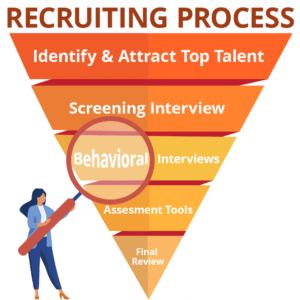If you’re looking to add a top sales performer to your team that has the skills, knowledge, leadership, drive, values, and forward-thinking to help take your business to the next level, there are measures you can take to make sure you avoid common hiring pitfalls. Believe it or not, interviewing and hiring, especially at this level, is one of the biggest risks your company can take.
I have broken down preparations to hire into three foundational steps to ensure you effectively define, seek-out, screen and secure top sales performers. These measures will be essential at any time, but especially going into 2021 when there are many unknowns possibly instore for market conditions. Be careful not to shortcut these best practices or you risk paying for it 10-fold in the form of costly sales turn-over and just as importantly, loss of precious time. This is a time for honest reflection on your previous sales hiring track record.
Step 1: Refine the Position Description & Develop an Ideal Candidate Profile
Step-back and review how well your current position description reflects the new selling environment that has revealed itself since the pandemic hit. What are you anticipating will happen in 2021, in 2022, and beyond? For example, there may have been positions that previously required 80% travel but converted into roles that were just as effective with limited outside activity and increased inside phone or video conferencing, or perhaps a more equal balance of outside and inside sales activity. Which model seems to be the most sustainable it the long run? Will your next hire be open to additional travel if needed down the line?
Another area to carefully evaluate are duties that involve team interaction. Be sure there are clear lines of accountability on expected outcomes. This crucial step in the process is to bring complete clarity to what you’re truly looking for in your candidate and what role they will play in your business.
Next, build out an Ideal Candidate Profile, which differs from the position description you just refined. The position description identifies the role’s purpose, essential duties and responsibilities, and a laundry list of qualification requirements including education and experience. The ideal candidate profile is laser focused on key accountabilities and non-negotiable requirements necessary to ensure the candidate is qualified. Done properly, this is a thought-provoking exercise concentrated on defining ideal mind-set, prior experience, and skill set.
Step 2: Develop a Recruiting Plan
The next step is to create a plan to bring candidates through a diligent Sales Recruiting Process. To effectively navigate each stage, factors to consider are expertise, budget and time. Recruiting top sales talent requires the expertise to identify the best players. Using a professional recruiter or inside resources will drive the budget. A time commitment from all those involved is a requirement that cannot be avoided.
Attracting Top Talent
 A-Players are typically already successful in their current roles, with 90% currently employed. They are likely only willing to make a career move for the right opportunity. Hiring those who are already delivering results means a high probability of success throughout your sales team. A big pitfall is posting ads with an expectation that top-tier talent will respond. A variety of tactics need to be deployed to draw out leading talent including direct sourcing (recruiters), social networking, creative advertising, and professional networking.
A-Players are typically already successful in their current roles, with 90% currently employed. They are likely only willing to make a career move for the right opportunity. Hiring those who are already delivering results means a high probability of success throughout your sales team. A big pitfall is posting ads with an expectation that top-tier talent will respond. A variety of tactics need to be deployed to draw out leading talent including direct sourcing (recruiters), social networking, creative advertising, and professional networking.
Screening Interview
Think of this stage as an opportunity for candidates to “audition” for a face-to-face meeting or furthering along in the recruiting funnel. The objective of this first interaction is to weed out those that do not fit your ideal candidate profile and non-negotiable requirements before moving on.
Behavioral Interviews
This series of interviews should take place with the hiring manager and then separately with other team members – either individually or as a group. Here, the objective is to move past the resume and focus on demonstrated skills and abilities. The hiring manager can focus on specific sales skills while each of the team members can be assigned specific behavioral traits to probe. The result should be a 360-degree view of the candidate.
Objective Assessment
There are a wide range of assessment tools available that can provide an objective analysis of the candidate. Depending on need, this analysis can measure skill, culture and personality against both position requirements and external benchmarks. Adding this element to the process provides insurance that what was heard in the other interviews is real.
Final Interview
Once the finalist has been identified, the last interview ties up any remaining issues and allows an opportunity for a discussion of the terms of employment. This last phase is often helpful in confirming the candidate’s motivations and desire to move forward.
Step 3: Be Prepared to “Sell” the Opportunity
It is important to understand that A-level Players will be screening you as much as you are screening them. That is just how their mindset works. To keep them engaged, be sure to keep a balance of assessing them while also selling them on your company, your product’s value proposition, career path potential, etc. Once you get a few steps into the recruiting process, you should know what makes the candidate tick, what they are looking for next in their career, and what it will take for them to make a move. A-Players want to be amongst winners so it is entirely possible that you may need to showcase the company’s vision and leadership team to help them visualize where the company going, its readiness to do so, and the critical role they’d fill to help make it happen.
Recruiting and hiring an A-Player is the right move for any business, but in order to get the right person into the right seat, there are several steps you need to take to ensure proper alignment. Our next blog will focus on defining your company’s onboarding process to make sure your A-Players thrive and flourish within your organization.







Leave A Comment